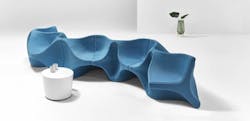Nienkämper’s Heartbeat Is Designed to Encourage Conversations Among Users
Enter the Nienkämper showroom in Chicago’s theMART, and you’ll immediately notice the Toronto-based company’s newest take on furniture design: Heartbeat.
The complex piece, designed by Karim Rashid, gives meaning to its name through its uncommon form. Heartbeat was designed to facilitate conversation and to encourage the sharing of heart-to-heart moments among fellow users.
It took 22 people and multiple iterations to finalize Heartbeat’s extra-long frame. Once perfected, Heartbeat made its grand debut at NeoCon this summer and wowed attendees with not only its shape, but bold aqua color and comfortably fitting fabric that molds to its frame.
“Heartbeat utilizes a unique fabric by Unika Vaev called ZOOM that offers a four-way stretch—a crucial factor in being able to cover Heartbeat’s many twists and turns,” says Ann-Marie Snook, president of Nienkämper.
The company has been creating fine office furniture for over 50 years, but Heartbeat proved to be an especially challenging feat with its multiple grooves and curves. Learn how it was created in our Q&A with Snook below, including a bonus insight from Rashid.
interiors+sources: How long did it take to develop Heartbeat?
Ann-Marie Snook: Heartbeat was a year-plus in the making. World-renowned designer Karim Rashid presented the original concept and sketches to our team in February of 2018.
The final product didn’t officially launch until June of 2019 at NeoCon in Chicago. Karim’s inspiration behind the design was to address the social alienation that contract design can often impose on public spaces.
i+s: How did the name for the product come about?
AMS: Heartbeat’s name was conceptualized by Karim. The lounge resembles a wave or a pulse, keeping people from being seated back-to-back, which allows for more effortless interaction.
Heartbeat was designed to facilitate conversation and suggests sharing a “heart to heart” with fellow human beings.
i+s: What was the inspiration behind Heartbeat?
Karim Rashid: I created Heartbeat out of my own needs. I travel constantly and am always having meetings in public spaces, hotel lobbies, cafes or clients’ showrooms. It is astounding to experience the lack of thought put into so much public and contract work.
I designed Heartbeat as a pulsating, alive respite to stagnation. Secondly, it is a continuation of my modular scape designs. Repositioning these three elements allows for the creation of a myriad of unique, morphing, undulating, physical landscapes.
i+s: What was the biggest hurdle in bringing Heartbeat to life?
AMS: Heartbeat went through five different iterations before going into production. Many of the challenges that arose were primarily due to its large scale. We’re working with a big piece to mold and a big piece to handle. A team of 22 people spent a lot of time fine-tuning the shape to ensure we had the best mix of comfort, spacing and scale.
We also faced some hurdles when it came time for upholstery. We decided to cut parts in half to make it easier to upholster and handle.
[Related: Patcraft’s Metal Collective Inspired by Japanese Art of Kintsugi]
i+s: What types of environments do you see this piece working in?
AMS: Heartbeat was imagined for any space where human interaction should be encouraged but is inhibited due to various design factors or other cultural aspects specific to each environment.
We envision Heartbeat fitting seamlessly into workplace, healthcare, education, hospitality and other commercial settings.
i+s: Does it come in different colors or size options?
AMS: There are over 25 fabric options and colors available, including this Unika Vaev ZOOM 728/35 Aqua. This reconfigurable and scalable system is composed of three distinct seating elements—Straight, Concave and Convex—which allow for it to grow and change depending upon the needs of its environment.
From the three elements, the user can create a multitude of configurations from circular, straight, serpentine and zigzag.
i+s: What kind of fabric did you use on Heartbeat to work with its uncommon shape?
AMS: Heartbeat utilizes a unique fabric by Unika Vaev called ZOOM that offers a four-way stretch—a crucial factor in being able to cover Heartbeat’s many twists and turns. However, both vinyl and leather can also be specified but require additional seams to accommodate Heartbeat’s form.
i+s: How has the response been to Heartbeat since its debut?
With Heartbeat’s unique shape that allows you to never sit back-to-back, it’s truly a collaborative, flexible furniture piece that’s been missing from workplace design.
i+s: What’s your hope for the product?
AMS: Heartbeat is instantly recognized for its unique sculptural form. We hope people recognize it as a one-of-a-kind flexible solution with seating on both sides, therefore providing more seats in a smaller footprint.
i+s: Are there any changes to the product on the horizon?
AMS: We are currently working on several new iterations for this piece. We hope to introduce an outdoor version of Heartbeat that is applicable for any outdoor office, hospitality or commercial setting.
Additionally, we’re working on innovative magnetic connectors that will provide additional flexibility, reconfigurability and ease of assembly.
i+s: What’s something people might not know about the product?
AMS: Heartbeat possesses a few noteworthy elements that some people may not know simply because they are not visible when looking at the final product.
For example, it features an indestructible rigid foam construction with a highly resistant flexible foam cover. In addition, the sofa sections are dowelled together with wood and steel to ensure solid construction.
Read next: How Durkan’s New Collection Preserves Centuries of Design Tradition
About the Author

Adrian Schley
Associate Editor
Adrian Schley was an Associate Editor for i+s, where she covered the commercial interior design industry since 2018. Her work can also be found in BUILDINGS and Meetings Today.
